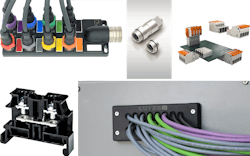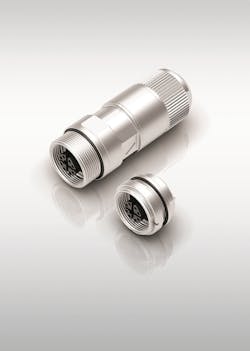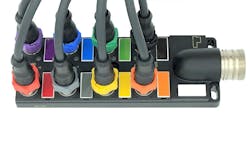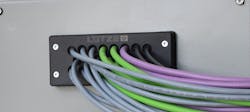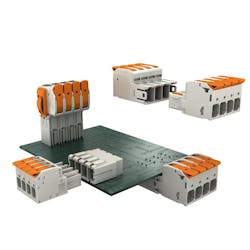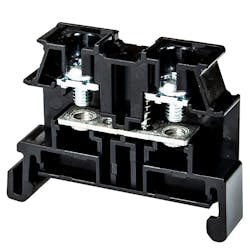As Industry 4.0 and connected machines continue to touch more industrial automation applications, machine components are changing to match data and connection needs, including the cables and connectors that are bringing machines together. Connectors and cables must be able to handle more data, at faster speed and often in rough conditions. Five manufacturers—Binder USA, Turck, Lutze, Wago and Dinkle—share their cable and connector solutions for smart machines and networked components, legacy updates and rugged applications.
High-speed transfer
As more applications shift toward connected machines, using the Industrial Internet of Things (IIoT) to move data and perform operations, those smarter and faster applications need comparable connectivity. “As these markets continue to expand, we see many new innovative trends developing throughout the entire automation industry,” says Maciek Czerwinski, director of sales and business development at Binder USA. “As industrial-automation applications become smarter, the demand for these industrial-grade high-speed connectivity requirements continues to grow.”
With that in mind, Binder launched its newest connector product, M16 X-code. The connector keeps the legacy of the M16 but helps to integrate users for the transition into connected technology, Czerwinski says. “We wanted to continue to evolve the offering within the same footprint. The driving force of the release of the M16 X-code was specifically for the Industry 4.0 integration,” he says.
The M16 connector uses the same footprint but is better optimized for high-speed data transfer with a density pin count up to 24 contacts (Figure 1). This allows for more connections and allows engineers to create hybrid solutions mixing power and signal. Binder sells largely to OEM customers, for use in any applications that require high-speed data computing. “The list of applications is virtually endless, from machine vision, autonomous technology, robotics, industrial wireless access points, industrial Ethernet switches, PLCs, virtually any application that requires an industrial high-speed transfer,” Czerwinski says.
Figure 1: Binder’s M16 X-code connector is optimized for high-speed data transfer.
The connection is suitable for outdoor and rugged environments, with an IP67 rating. The installation displacement termination (IDT) style makes it ideal for robust and harsh environment applications with high transmission rate data requirements. IDT involves splicing into the wire vs. soldering, crimping or screw terminating. “It offers an ideal solution for field assembly with this type of connectivity,” Czerwinski says. “The key benefit of the IDT termination is realistically the connectivity or the security of the connection, for basically any application that has a high vibration.”
Czerwinski says the Binder M16 chassis has been proven in many rugged applications. The design originated with the M12 X-code, which Czerwinski says is an industry standard for use with 10 Gb industrial Ethernet. Binder used the same internal components with the M16 chassis.
“With industrial Ethernet and high-speed Cat. 6 to Cat. 7 applications, the cabling is critical when the pairs are obviously twisted, and now they are individually shielded twisted pairs, and this is critical when protecting against potential insertion loss or any impedance concerns,” he says. “The X-code has basically an x-shaped shield, which splits up the individual pairs, so the shield protection continues throughout the inside of the chassis all the way to the connection point on the application. Your insertion loss and your impedance are virtually seeing zero loss and your connectivity speeds are continuing without any interference.”
A bad cable can make the best connector fail and vice versa, Czerwinski says. “The application is only as strong as the cable and connector being used,” he says, adding the most common reason for insertion loss is using the wrong cable for the length of the run. For example, a Cat. 6 cable is rated for 10 Gb/s at 55 m, where a Cat. 6a can increase the length to 100 m at the same speed. A bad termination to the connector can be another reason for impedance loss. Czerwinski says impedance is protected by making sure the connector and cable are properly terminated.
Patented torque sleeve
Turck’s next-generation M12 cordsets and receptacles are based on the company’s legacy connectors developed decades ago and redesigned with features to make installation easier, quicker and more reliable. The sensor actuator cables are used on a wide variety of automation applications, any kind of machine that would have a sensor or an actuator on it, says Lewis Fiecke, product manager at Turck. For these types of applications, “M12s are by far the most common,” Fiecke says. “This is a connector that will connect your sensor or actuator to your fieldbus or your distributed I/O station or directly to a controller.”
Customization has always been our main differentiator at Turck, Fiecke says. With a very broad offering, the company’s products fit into many categories and suit many different customers, he adds. “That’s where Turck has been a differentiator,” Fiecke says.
The M12 upgrade was intended to expand the company’s market share by improving on some mismatching and duplication on the old product and making it more modular overall. For its internal processes, Turck consolidated raw materials as much as possible and simplified the manufacturing to be more consistent and automatable, Fiecke says. “To help us get lead time and costs down, and on the commodity side of things, this is really important,” he adds.
The M12 connectors have a keyway indicator to help installation. “You need to align that keyway on the cordsets, either to the sensor or the junction box or receptacle or whatever it’s mating to,” Fiecke says. In certain situations, it can be difficult or time-consuming to locate the keyway prior to mating, or it could be entirely obstructed by other components. To make it easier, the keyway indictor is a little piece of plastic in the mold body. “Installers can both see and feel where the keyway is located,” Fiecke says.
Once the pins are properly aligned, the connector needs to be tightened to a certain torque in order to properly mate. In some applications, Fiecke says, “finger-tight” is good enough. However, finger-tight is also relative to the installer, and over-tightening or under-tightening the locknut can cause ingress paths. “Over the past five years, we’ve seen a huge increase in the use of a torque wrench,” Fiecke says. “It will mate at a defined torque. It’s very precise. It works well, but these tools are expensive.”
When finger-tight isn’t good enough and torque wrenches are not available, Turck designed this M12 connector with a patented torque sleeve. “The torque sleeve will actually cam out once the connector is tight enough and that will ensure the IP rating or ingress protection rating,” Fiecke says. The torque sleeve, which sits on the coupling nuts, provides a tactile click at the right torque (Figure 2). The new cordsets are IP67-, IP68- and IP69-rated and work for applications that need vibration-proof connections.
Figure 2: Turck’s M12 cordsets and receptacles use a torque sleeve to facilitate hand tightening to the proper torque.
The torque sleeves also come in nine different colors, which can help end users distinguish one connection from another. Instead of changing an overmold color, end users can pick torque sleeve colors to coordinate with their receptacles, panels or junction boxes. “If you have to tear it down and demate, it’s just quicker and easier,” Fiecke says. The torque sleeves are also very inexpensive and don’t add anything to the cost of the cordsets, and Turck stocks them in large quantities.
Multi-cable solution
Lutze is also focused on the impacts of IIoT and increased electronic connectivity on machines. “In automation generally, I would say the past 15 to 20 years has seen a shift away from hydraulic and pneumatic systems and a move toward electric automation,” says Matt Tarney, product manager for cable and connectivity products at Lutze. “That involves a lot more sensors. It involves networking the components on a machine, and all of those interconnections require some kind of physical cabling in most cases, so the density of cabling on a piece of equipment has gotten higher.” All this had led to a growing market for cable entry systems, Tarney says.
The end goal of Industry 4.0 and Ethernet networked components on industrial equipment “is really to gather as much data as we possibly can from our manufacturing processes,” Tarney says. Data-rich machines can use software with machine learning or artificial intelligence to improve processes. “But the collection and transmission of that data all requires a reliable interconnection of equipment, and that’s hard to achieve with wireless solutions, so that’s typically done with a hardwired Ethernet cable. And, the more connected devices on a piece of machinery, the more cabling needed to facilitate those connections. “That’s increasing the density of physical cabling, which requires new solutions for managing that,” Tarney says.
Lutze’s Cablefix X entry system fills a growing need for multi-cable solutions and provides quicker installation and setup over individual cable glands. Lutze launched the original Cablefix product in Germany in the early 1990s, and the company recently saw the need for a product geared specifically toward the U.S. market that provided ingress protection compliant with UL ratings. The Cablefix X entry system was launched in 2019, as a medium-duty cable entry plate designed for cables without connectors.
The main markets for Lutze’s cable entry system are OEMs producing equipment for installation in a factory environment, as well as UL 508A cabinet shops, which build and repair control panels. “When you look at verticals, it’s really very wide open,” Tarney says. “Aside from some niche applications, such as hazardous locations or high-pressure washdown, Cablefix X can be used in almost any industry and application.”
Traditionally, cable glands are used to individually seal cables that pass from the inside to the outside of an enclosure. “If you can imagine you have 18 cables,” Tarney says, “if you’re using cable glands, you’re punching a hole for each one of those glands.” Individually installing and fitting each cable gland is time-consuming. “The space that it takes up on the side of your enclosure is also quite large,” Tarney says.
The Cablefix X cable entry system helps many of those issues, making the installation of multiple cables into an enclosure faster and covering a smaller footprint. In 2018, Lutze did an in-house study, looking at the time it took one installer to install cables using cable glands and the same thing using the Lutze system.
“Using the Cablefix X system can reduce your cable installation time by 80% or more and reduces the footprint of those cables on your enclosure by 50% or more,” Tarney says.
Figure 3: Lutze’s Cablefix X cable entry system has a self-healing membrane that can close cable holes without a blanking plug.
The frame is rated to UL Type 4X, 12, 13 and IP65, making it suited for harsh environments. A self-healing membrane also makes the system more flexible (Figure 3). “We designed our system with a layered seal. We have some polymer seals on the front and back of that seal. We have a layer for physical strength and strain relief, and then we have this gel membrane that’s inside the sealing membrane,” Tarney says. The proprietary gel is water-blocking, so if water hits the gel, it swells up to prevent water ingress. “That’s one of the ways we achieve that 4X rating: that is actively defending against water ingress,” Tarney says. The gel is also self-healing. If cable needs to be removed, the membrane will close back up over the hole and a blanking plug isn’t needed. The system uses a standard 112-by-36 mm cutout compatable with many third-party punches.
Dynamic connection
Wago has seen an exploding market and demand for connectors in recent years. “I think that’s driven primarily by the trend toward smarter and smarter machines that are more connected,” says Cory Thiel, product manager for PCB interconnect products for Wago North America. “It’s driving a lot of demand for connectors and a lot of variety of different types of connectors.” He says the expanding market is also driving the need for smaller and smaller components. “People are always wanting to do more functionality in the same or less space.”
With the 832 series Maxi connector, Wago packs a powerful connection into a compact solution (Figure 4). This product is geared toward power termination applications, particularly field-wired connections, which can be cumbersome, Thiel says.
Figure 4: Wago’s 832 series Maxi connector has a small footprint but supports high power connections.
The product was launched in early 2019 and put Wago’s spring pressure connection technology in a powerful, small package for field-wired applications. Instead of a screw terminal, which requires a torque screwdriver for installation, or a crimp terminal, which also requires a special tool to appropriately crimp the wire, the lever operation of the spring pressure connection technology requires no tools.
Field connections can be made by lifting the lever, inserting a stripped conductor and lowering the lever. Wago’s spring pressure connection is also dynamic, Thiel says. “Once you make the connection, that connection is, because of the spring, dynamic in nature, and it’s free to adjust for environmental impacts that could affect other static termination solutions,” he says. This can compensate for vibration, thermal cycling or corrosion that can degrade connections.
The connector system includes various configurations for wire-to-wire, wire-to-board and through-panel, as well as panel or DIN-rail mounted solutions. They can be used throughout the electrical cabinet or as a power device connection in many high-power, high-current applications, such as EV chargers, PV inverters, energy storage systems, UPS systems, power supplies and 5G antenna systems.
“We’re able to combine with the 832, relative to its current capacity, a relatively small connector, and with that easy termination without any tools and with high performance from a current and voltage perspective,” Thiel says.
The 832 series connector eases the mating and unmating of a female/male connector. “This is a higher-power device. It’s a little bit larger device. Usually, the larger you get in devices, you’re dealing with more and more friction because you need more and more metal to make those connections and carry those higher currents,” Thiel says. “Lots of friction usually means it’s difficult to connect and disconnect the male and female portions of the connections.”
The 832 series connector eases this process by plating the mating surfaces with a hard silver coating. Thiel says that silver coating is a lot harder and less porous than most contact surfaces, which makes for very smooth mating and unmating of the male/female contact.
The push-in cage clamp termination works for wire sizes 18 to 4 AWG, rated up to 85 A/600 V. It meets the requirements for UL 61800-5-1 for front panel accessible connections in electrical drive systems. The connector is touch-proof, as the operator cannot make contact with internal live parts. This is important for many industries and particularly for field-wired applications, Thiel says.
Updated screw connection
Like many in the industry, Dinkle is trying to push the market in new directions with push-in type connections, but much of the labor force is still used to traditional screw-in type methods. Dinkle provides many connectors with newer technology, but it has also given its traditional screw connection terminal block an upgrade. “We’re trying to provide some type of upgrade from the traditional or conventional wiring methods,” says Matt Hou, sales engineer at Dinkle.
DKU, Dinkle’s latest version of the screw connection terminal block, is designed with spring guided screws for automatic screw alignment (Figure 5). This barrier type terminal block is used mainly for high-power applications, and it works well in harsher environments with high vibration, Hou says. The screws are integrated with washers for vibration-proof and secure connections, and the washers are made with steel, plated with zinc, to prevent them from rusting.
Figure 5: Dinkle’s DKU screw connection terminal block includes spring guided screws for automatic alignment.
DKU works with ring- and U-shaped cable lugs, which are used to provide a more secure connection and prevent the screw from falling out. Traditionally, users have to back the entire washer and screw out of its fitting and then insert the U-shaped cable and reinsert the screws and washer. “We think that this will provide some potential problems. What if they lose the screw? Or what if it falls out and they can’t find it?” Hou says. With the spring-guided system, the screw is held on top in its top position at all times, unless it’s pushed down and screwed in. “Once a ring-shaped cable is inserted, they are able to align it accordingly because it doesn’t have a wire cage, as conventional terminal blocks do, and push it down, so that the ring lug and the screw are aligned properly before screwing it down,” Hou says.
Dinkle designed the product for power transmission in control panels and power-distribution cabinets, and those that have high vibration, such as transportation or railway. The product has two series, for DIN-rail or panel mounts.
In addition to preventing the screws from falling out, the terminal block encloses the screws and conductors. Typical barrier-type terminal blocks lack a cover over the screw, and DKU provides an extra level of protection for the user. “There is a cover to protect the operators from touching the screws or any parts within,” Hou says. “This also provides extra safety for the installation and the maintenance.”
ALSO READ: Push-in terminal block technology dominates
About the Author
Anna Townshend
Managing Editor
Anna Townshend has been a writer and journalist for 20 years. Previously, she was the editor of Marina Dock Age and International Dredging Review, until she joined Endeavor Business Media in June 2020. She is the managing editor of Control Design and Plant Services.

Leaders relevant to this article:
